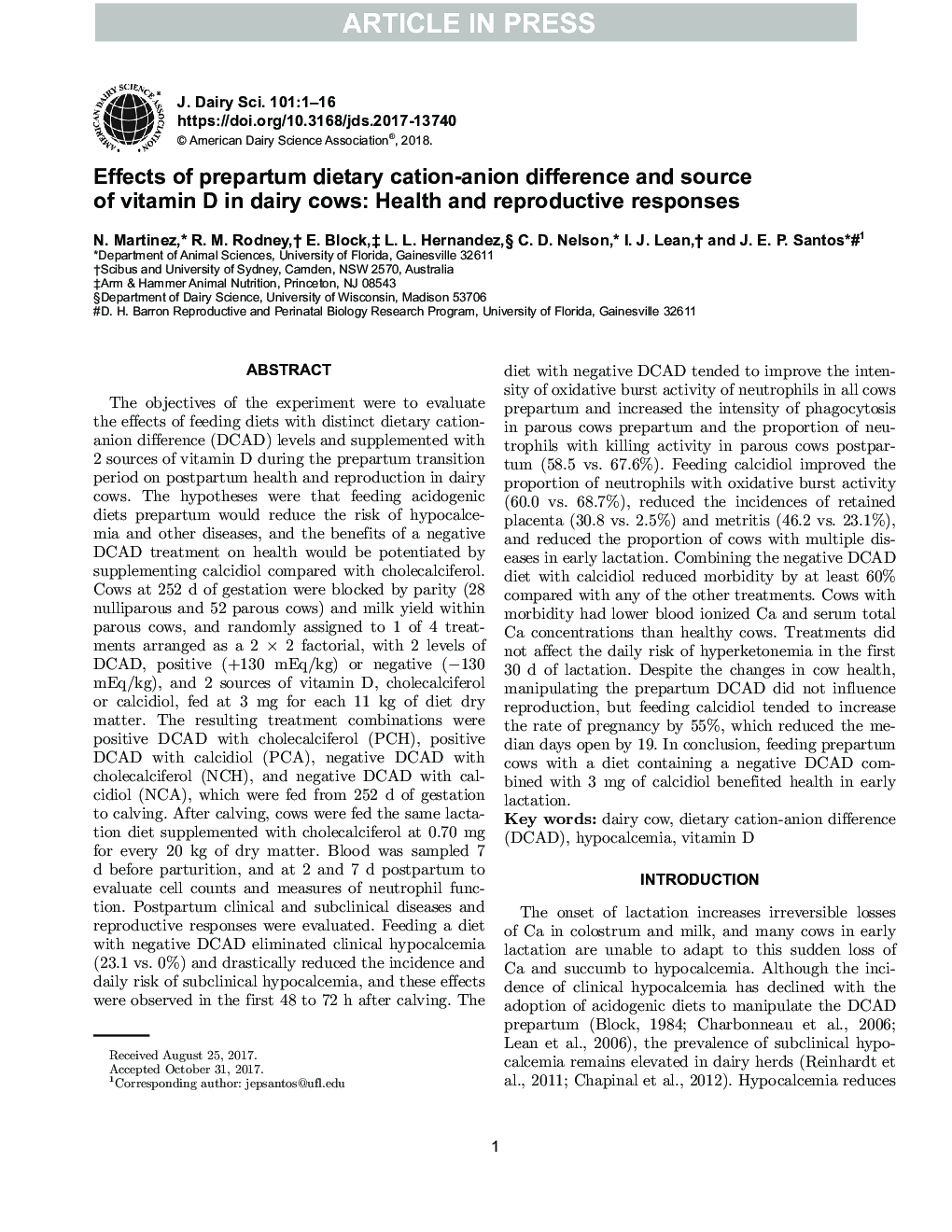| کد مقاله | کد نشریه | سال انتشار | مقاله انگلیسی | نسخه تمام متن |
|---|---|---|---|---|
| 8501470 | 1553842 | 2018 | 16 صفحه PDF | دانلود رایگان |
عنوان انگلیسی مقاله ISI
Effects of prepartum dietary cation-anion difference and source of vitamin D in dairy cows: Health and reproductive responses
دانلود مقاله + سفارش ترجمه
دانلود مقاله ISI انگلیسی
رایگان برای ایرانیان
موضوعات مرتبط
علوم زیستی و بیوفناوری
علوم کشاورزی و بیولوژیک
علوم دامی و جانورشناسی
پیش نمایش صفحه اول مقاله

چکیده انگلیسی
The objectives of the experiment were to evaluate the effects of feeding diets with distinct dietary cation-anion difference (DCAD) levels and supplemented with 2 sources of vitamin D during the prepartum transition period on postpartum health and reproduction in dairy cows. The hypotheses were that feeding acidogenic diets prepartum would reduce the risk of hypocalcemia and other diseases, and the benefits of a negative DCAD treatment on health would be potentiated by supplementing calcidiol compared with cholecalciferol. Cows at 252 d of gestation were blocked by parity (28 nulliparous and 52 parous cows) and milk yield within parous cows, and randomly assigned to 1 of 4 treatments arranged as a 2 Ã 2 factorial, with 2 levels of DCAD, positive (+130 mEq/kg) or negative (â130 mEq/kg), and 2 sources of vitamin D, cholecalciferol or calcidiol, fed at 3 mg for each 11 kg of diet dry matter. The resulting treatment combinations were positive DCAD with cholecalciferol (PCH), positive DCAD with calcidiol (PCA), negative DCAD with cholecalciferol (NCH), and negative DCAD with calcidiol (NCA), which were fed from 252 d of gestation to calving. After calving, cows were fed the same lactation diet supplemented with cholecalciferol at 0.70 mg for every 20 kg of dry matter. Blood was sampled 7 d before parturition, and at 2 and 7 d postpartum to evaluate cell counts and measures of neutrophil function. Postpartum clinical and subclinical diseases and reproductive responses were evaluated. Feeding a diet with negative DCAD eliminated clinical hypocalcemia (23.1 vs. 0%) and drastically reduced the incidence and daily risk of subclinical hypocalcemia, and these effects were observed in the first 48 to 72 h after calving. The diet with negative DCAD tended to improve the intensity of oxidative burst activity of neutrophils in all cows prepartum and increased the intensity of phagocytosis in parous cows prepartum and the proportion of neutrophils with killing activity in parous cows postpartum (58.5 vs. 67.6%). Feeding calcidiol improved the proportion of neutrophils with oxidative burst activity (60.0 vs. 68.7%), reduced the incidences of retained placenta (30.8 vs. 2.5%) and metritis (46.2 vs. 23.1%), and reduced the proportion of cows with multiple diseases in early lactation. Combining the negative DCAD diet with calcidiol reduced morbidity by at least 60% compared with any of the other treatments. Cows with morbidity had lower blood ionized Ca and serum total Ca concentrations than healthy cows. Treatments did not affect the daily risk of hyperketonemia in the first 30 d of lactation. Despite the changes in cow health, manipulating the prepartum DCAD did not influence reproduction, but feeding calcidiol tended to increase the rate of pregnancy by 55%, which reduced the median days open by 19. In conclusion, feeding prepartum cows with a diet containing a negative DCAD combined with 3 mg of calcidiol benefited health in early lactation.
ناشر
Database: Elsevier - ScienceDirect (ساینس دایرکت)
Journal: Journal of Dairy Science - Volume 101, Issue 3, March 2018, Pages 2563-2578
Journal: Journal of Dairy Science - Volume 101, Issue 3, March 2018, Pages 2563-2578
نویسندگان
N. Martinez, R.M. Rodney, E. Block, L.L. Hernandez, C.D. Nelson, I.J. Lean, J.E.P. Santos,